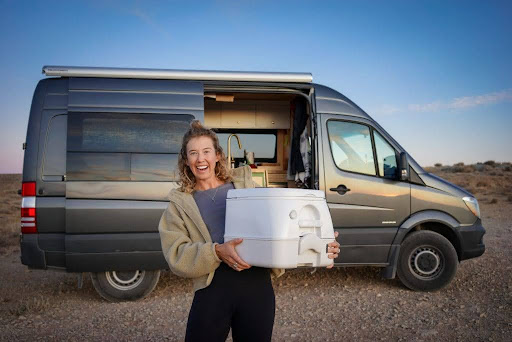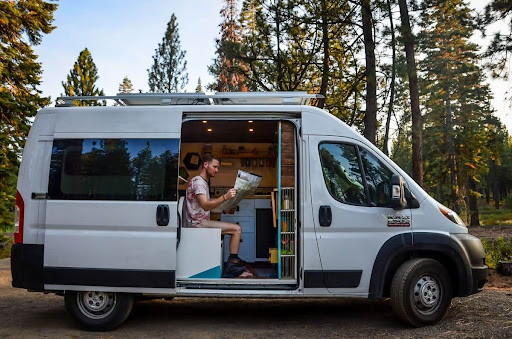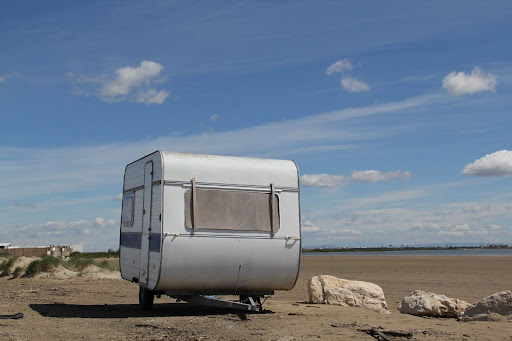Let’s just say I wasn’t ready for the drama of a full bladder at 5 AM with a locked campground restroom.
That’s the moment I realized the true value of my humble cassette toilet. Yes, it’s not glamorous. But it’s a game-changer when you’re camping in Big Bear, road-tripping through the desert, or parked at a trailhead miles from civilization.
If you’re exploring life on wheels or just want a no-fuss backup toilet option, this compact hero deserves your attention.
What is a Cassette Toilet?
A cassette toilet is a self-contained portable toilet with a built-in waste tank that can be removed, emptied, and cleaned.
It looks like a traditional RV toilet on top. But below? A slide-out tank (the “cassette”) that you can discreetly dump at any restroom or dump station.
You don’t need a huge black tank setup or plumbing overhaul. It’s perfect for vans, compact RVs, overland rigs, or even tiny cabins.
Why I Ditched the Bucket and Went Cassette

Image source : The Russos
Before I upgraded, I used the ol’ “pee bottle and bucket combo.” Yikes.
Not only was it awkward, it quickly became… unpleasant. Especially in colder weather or when privacy was an issue. A cassette toilet gave me dignity back. It felt more like a real bathroom experience—flushing and all—but without the black tank drama.
The Ups and Downs: Is It Right for You?
Here’s a breakdown of what I’ve learned using my cassette toilet full-time.
Pros
- Compact and doesn’t take up precious space
- No hose hookup or permanent plumbing needed
- Easy to dump in public restrooms or RV facilities
- Most have manual or electric flush features
Cons
- The waste tank fills fast (think every 2–4 days)
- Dumping can be awkward in public if you’re shy
- Strong odors if you skip the right chemicals
- Not ideal for families or high-traffic use
If you’re a solo traveler or couple, it works beautifully. Larger groups might need a more robust system.
Daily Use Tips I Wish I Knew Sooner

Image source: www.reha.al
Cassette toilets are low-maintenance, but a few tricks make life easier.
First—always add a little water to the bowl before doing your business. It helps things flush cleanly and keeps the cassette from sticking.
Second, use cassette-safe chemicals. The good ones reduce odor, break down waste fast, and prevent clogs. I personally like the stuff from Thetford and Walex—they’re affordable and RV-safe.
Lastly, don’t overfill. Most tanks have a level indicator. Empty as soon as it hits ¾ full. Trust me, you don’t want to find out what happens if you ignore that warning.
Cassette vs. Composting Toilets: Which Is Better?
I get this question constantly. Here’s my honest take.
Cassette toilets are better for people who want minimal setup, a real flush, and don’t mind dumping every few days.
Composting toilets are waterless and good for long-term off-grid living. But they require separation of liquids/solids, more frequent attention, and a tolerance for, well, mixing things.
| Feature | Cassette Toilet | Composting Toilet |
| Water Needed | Yes (small amount) | No |
| Flush Feature | Manual or electric | None |
| Frequency of Emptying | Every 2–4 days | Solids: 2–3 weeks |
| Installation | Easy, plug-and-go | Larger, more involved |
| Smell Control | Chemical-based | Ventilation + composting |
If simplicity is key, go cassette. If sustainability is your jam, compost might win.
Winter in Big Bear? Here’s How to Keep It From Freezing

Image source: Two Wandering Soles
Living in the mountains means I’ve learned a thing or two about frozen tanks.
To keep your cassette toilet working in winter, add a bit of non-toxic RV antifreeze to both the fresh and waste tanks. Just a splash helps prevent ice buildup.
Also, keep the exterior cassette door clear of snow. A frozen hatch is no fun when nature calls.
When in doubt, store the unit indoors overnight if temps drop too low.
Is Dumping It Really That Gross?
Surprisingly, not really.
Modern cassettes are designed for clean, sealed transport. Most have built-in handles and wheels, so you’re not sloshing a tank around.
I wear gloves, dump it quickly in a toilet or dump station, rinse with water, and add a fresh shot of toilet chemical before reinstalling.
Done in under 10 minutes.
And let’s be real—it’s still better than a sketchy gas station bathroom at 1 AM.
Questions People Keep Asking Me
Where can you dump a cassette toilet?
Anywhere with a standard toilet or RV dump station. I’ve used campground restrooms, state park facilities, and even highway rest stops.
How long can you go before dumping?
Usually 2–3 days with daily use. Less if you’re sharing. I check the indicator often and never let it hit full.
Does it smell inside the van?
Only if I forget to clean it. Using the right chemicals and emptying regularly keeps everything fresh. I also crack a window slightly for airflow.
What brand should I buy?
Thetford and Dometic are top-tier. Look for models with a rotating spout and level indicator—they make dumping way easier.
My Honest Verdict After a Year of Use
If you’re traveling light, living tiny, or just want a portable toilet that doesn’t make your nose cry—go cassette.
It’s compact, practical, and way less intimidating than it sounds.
I wouldn’t hit the road without it now. Not just for the convenience, but for the peace of mind. And that, my friend, is priceless.














